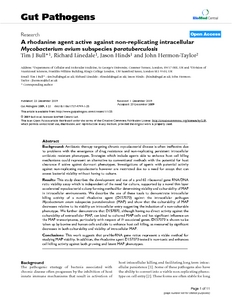Bull, TJ; Linedale, R; Hinds, J; Hermon-Taylor, J
(2009)
A rhodanine agent active against non-replicating intracellular Mycobacterium avium subspecies paratuberculosis.
GUT PATHOGENS, 1 (25).
ISSN 1757-4749
https://doi.org/10.1186/1757-4749-1-25
SGUL Authors: Bull, Timothy John Hinds, Jason
![[img]](https://openaccess.sgul.ac.uk/203/1.hassmallThumbnailVersion/1757-4749-1-25.pdf)  Preview |
|
["document_typename_application/pdf; charset=binary" not defined]
Published Version
Download (320kB)
| Preview
|
Abstract
BACKGROUND: Antibiotic therapy targeting chronic mycobacterial disease is often ineffective due to problems with the emergence of drug resistance and non-replicating persistent intracellular antibiotic resistant phenotypes. Strategies which include agents able to enhance host cell killing mechanisms could represent an alternative to conventional methods with the potential for host clearance if active against dormant phenotypes. Investigations of agents with potential activity against non-replicating mycobacteria however are restricted due to a need for assays that can assess bacterial viability without having to culture.
RESULTS: This study describes the development and use of a pre16S ribosomal gene RNA/DNA ratio viability assay which is independent of the need for culture, supported by a novel thin layer accelerated mycobacterial colony forming method for determining viability and culturability of MAP in intracellular environments. We describe the use of these tools to demonstrate intracellular killing activity of a novel rhodanine agent (D157070) against the intracellular pathogen Mycobacterium avium subspecies paratuberculosis (MAP) and show that the culturability of MAP decreases relative to its viability on intracellular entry suggesting the induction of a non-culturable phenotype. We further demonstrate that D157070, although having no direct activity against the culturability of extracellular MAP, can bind to cultured MAP cells and has significant influence on the MAP transcriptome, particularly with respect of delta(L )associated genes. D157070 is shown to be taken up by bovine and human cells and able to enhance host cell killing, as measured by significant decreases in both culturability and viability of intracellular MAP.
CONCLUSIONS: This work suggests that pre16srRNA gene ratios represent a viable method for studying MAP viability. In addition, the rhodanine agent D157070 tested is non-toxic and enhances cell killing activity against both growing and latent MAP phenotypes.
Statistics
Item downloaded times since 30 Apr 2012.
Actions (login required)
 |
Edit Item |



